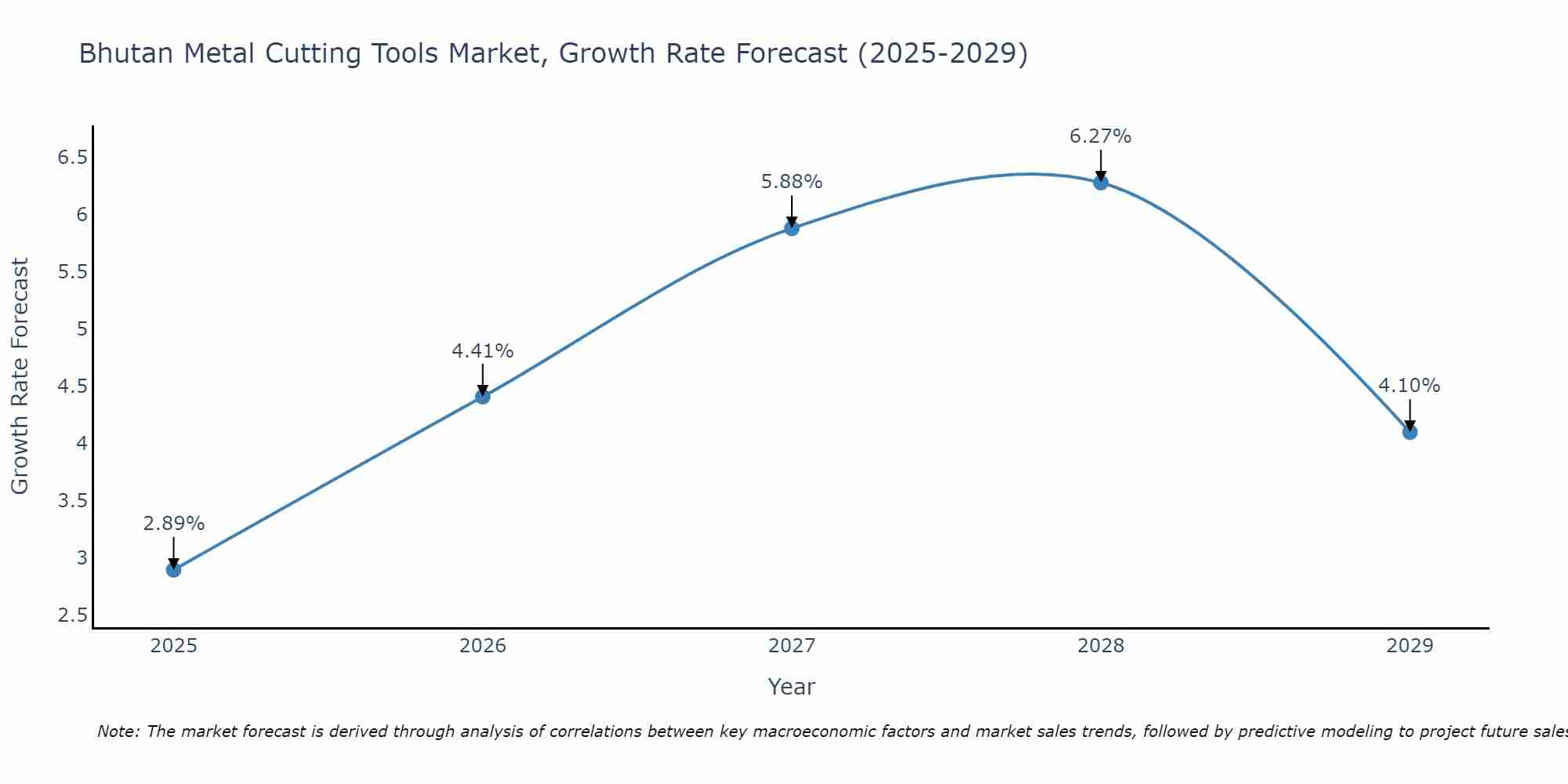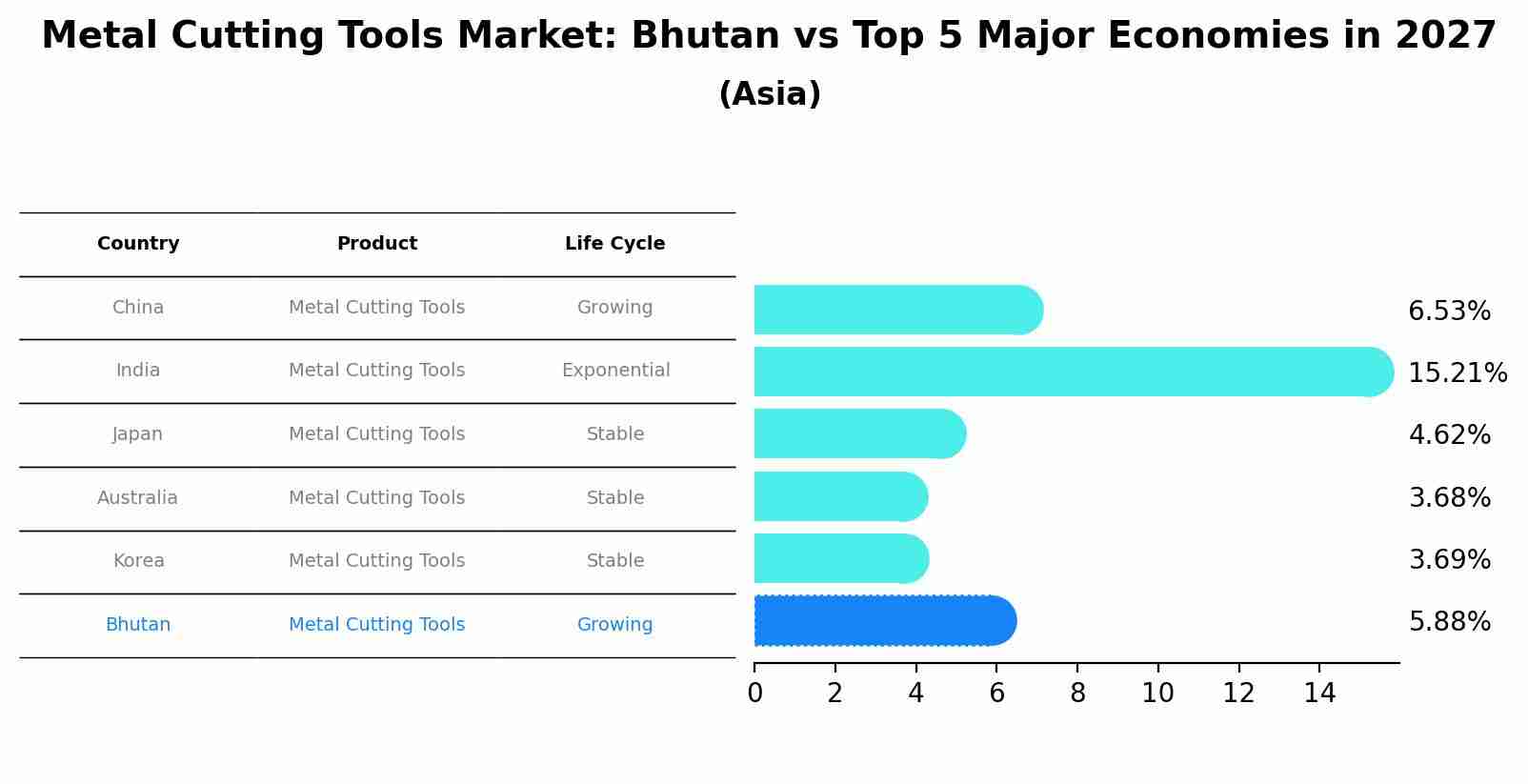Bhutan Metal Cutting Tools Market (2025-2031) | Forecast, Companies, Revenue, Trends, Outlook, Analysis, Value, Size, Industry, Share, Segmentation & Growth
| Product Code: ETC5196582 | Publication Date: Nov 2023 | Updated Date: Sep 2025 | Product Type: Market Research Report | |
| Publisher: 6Wresearch | Author: Bhawna Singh | No. of Pages: 60 | No. of Figures: 30 | No. of Tables: 5 |
Bhutan Metal Cutting Tools Market Size Growth Rate
The Bhutan Metal Cutting Tools Market is projected to witness mixed growth rate patterns during 2025 to 2029. The growth rate begins at 2.89% in 2025, climbs to a high of 6.27% in 2028, and moderates to 4.10% by 2029.

Metal Cutting Tools Market: Bhutan vs Top 5 Major Economies in 2027 (Asia)
In the Asia region, the Metal Cutting Tools market in Bhutan is projected to expand at a growing growth rate of 5.88% by 2027. The largest economy is China, followed by India, Japan, Australia and South Korea.

Bhutan Metal Cutting Tools Market Overview
The metal cutting tools market in Bhutan is small, reflecting the limited scope of manufacturing and metalworking activities. As the countrys industrial sector grows, there could be increased demand for advanced cutting tools in various applications.
Drivers of the market
The Bhutan metal cutting tools market is driven by the growth of the manufacturing and construction sectors. As Bhutan continues to develop its infrastructure and industrial capabilities, there is an increasing demand for high-precision cutting tools essential for fabricating metal components used in various applications. Technological advancements in cutting tools, such as the development of high-speed steel and carbide tools, further drive market growth by offering improved performance and durability.
Challenges of the market
The metal cutting tools market in Bhutan encounters challenges such as high production costs and competition from low-cost imports. Limited local manufacturing capabilities and infrastructure for producing advanced cutting tools can affect market stability. Additionally, ensuring product quality and compliance with industry standards pose ongoing challenges.
Government Policy of the market
In Bhutan, the metal cutting tools market is shaped by government policies that support the development and use of advanced cutting tools in manufacturing. The government provides incentives for the production and adoption of metal cutting tools through financial support and research grants. Policies focus on enhancing the efficiency and quality of cutting processes. Regulatory frameworks ensure that metal cutting tools meet performance and safety standards, contributing to their growth in the manufacturing sector.
Key Highlights of the Report:
- Bhutan Metal Cutting Tools Market Outlook
- Market Size of Bhutan Metal Cutting Tools Market, 2024
- Forecast of Bhutan Metal Cutting Tools Market, 2031
- Historical Data and Forecast of Bhutan Metal Cutting Tools Revenues & Volume for the Period 2021-2031
- Bhutan Metal Cutting Tools Market Trend Evolution
- Bhutan Metal Cutting Tools Market Drivers and Challenges
- Bhutan Metal Cutting Tools Price Trends
- Bhutan Metal Cutting Tools Porter`s Five Forces
- Bhutan Metal Cutting Tools Industry Life Cycle
- Historical Data and Forecast of Bhutan Metal Cutting Tools Market Revenues & Volume By Product for the Period 2021-2031
- Historical Data and Forecast of Bhutan Metal Cutting Tools Market Revenues & Volume By Machining Centers for the Period 2021-2031
- Historical Data and Forecast of Bhutan Metal Cutting Tools Market Revenues & Volume By Lathe Machines for the Period 2021-2031
- Historical Data and Forecast of Bhutan Metal Cutting Tools Market Revenues & Volume By Boring Machines for the Period 2021-2031
- Historical Data and Forecast of Bhutan Metal Cutting Tools Market Revenues & Volume By Grinding Machines for the Period 2021-2031
- Historical Data and Forecast of Bhutan Metal Cutting Tools Market Revenues & Volume By Milling Machines for the Period 2021-2031
- Historical Data and Forecast of Bhutan Metal Cutting Tools Market Revenues & Volume By Others for the Period 2021-2031
- Historical Data and Forecast of Bhutan Metal Cutting Tools Market Revenues & Volume By Application for the Period 2021-2031
- Historical Data and Forecast of Bhutan Metal Cutting Tools Market Revenues & Volume By Automotive for the Period 2021-2031
- Historical Data and Forecast of Bhutan Metal Cutting Tools Market Revenues & Volume By General Machinery for the Period 2021-2031
- Historical Data and Forecast of Bhutan Metal Cutting Tools Market Revenues & Volume By Precision Engineering for the Period 2021-2031
- Historical Data and Forecast of Bhutan Metal Cutting Tools Market Revenues & Volume By Transport Machinery for the Period 2021-2031
- Historical Data and Forecast of Bhutan Metal Cutting Tools Market Revenues & Volume By Others for the Period 2021-2031
- Bhutan Metal Cutting Tools Import Export Trade Statistics
- Market Opportunity Assessment By Product
- Market Opportunity Assessment By Application
- Bhutan Metal Cutting Tools Top Companies Market Share
- Bhutan Metal Cutting Tools Competitive Benchmarking By Technical and Operational Parameters
- Bhutan Metal Cutting Tools Company Profiles
- Bhutan Metal Cutting Tools Key Strategic Recommendations
Frequently Asked Questions About the Market Study (FAQs):
1 Executive Summary |
2 Introduction |
2.1 Key Highlights of the Report |
2.2 Report Description |
2.3 Market Scope & Segmentation |
2.4 Research Methodology |
2.5 Assumptions |
3 Bhutan Metal Cutting Tools Market Overview |
3.1 Bhutan Country Macro Economic Indicators |
3.2 Bhutan Metal Cutting Tools Market Revenues & Volume, 2021 & 2031F |
3.3 Bhutan Metal Cutting Tools Market - Industry Life Cycle |
3.4 Bhutan Metal Cutting Tools Market - Porter's Five Forces |
3.5 Bhutan Metal Cutting Tools Market Revenues & Volume Share, By Product, 2021 & 2031F |
3.6 Bhutan Metal Cutting Tools Market Revenues & Volume Share, By Application, 2021 & 2031F |
4 Bhutan Metal Cutting Tools Market Dynamics |
4.1 Impact Analysis |
4.2 Market Drivers |
4.2.1 Growing industrialization and manufacturing sector in Bhutan leading to increased demand for metal cutting tools. |
4.2.2 Technological advancements in metal cutting tools improving efficiency and precision in manufacturing processes. |
4.2.3 Government initiatives to promote local manufacturing industries boosting the demand for metal cutting tools. |
4.3 Market Restraints |
4.3.1 Limited availability of skilled labor for operating advanced metal cutting tools. |
4.3.2 Fluctuating raw material prices impacting the production costs of metal cutting tools. |
4.3.3 Lack of awareness about the benefits of using high-quality metal cutting tools among small and medium-sized enterprises in Bhutan. |
5 Bhutan Metal Cutting Tools Market Trends |
6 Bhutan Metal Cutting Tools Market Segmentations |
6.1 Bhutan Metal Cutting Tools Market, By Product |
6.1.1 Overview and Analysis |
6.1.2 Bhutan Metal Cutting Tools Market Revenues & Volume, By Machining Centers, 2021-2031F |
6.1.3 Bhutan Metal Cutting Tools Market Revenues & Volume, By Lathe Machines, 2021-2031F |
6.1.4 Bhutan Metal Cutting Tools Market Revenues & Volume, By Boring Machines, 2021-2031F |
6.1.5 Bhutan Metal Cutting Tools Market Revenues & Volume, By Grinding Machines, 2021-2031F |
6.1.6 Bhutan Metal Cutting Tools Market Revenues & Volume, By Milling Machines, 2021-2031F |
6.1.7 Bhutan Metal Cutting Tools Market Revenues & Volume, By Others, 2021-2031F |
6.2 Bhutan Metal Cutting Tools Market, By Application |
6.2.1 Overview and Analysis |
6.2.2 Bhutan Metal Cutting Tools Market Revenues & Volume, By Automotive, 2021-2031F |
6.2.3 Bhutan Metal Cutting Tools Market Revenues & Volume, By General Machinery, 2021-2031F |
6.2.4 Bhutan Metal Cutting Tools Market Revenues & Volume, By Precision Engineering, 2021-2031F |
6.2.5 Bhutan Metal Cutting Tools Market Revenues & Volume, By Transport Machinery, 2021-2031F |
6.2.6 Bhutan Metal Cutting Tools Market Revenues & Volume, By Others, 2021-2031F |
7 Bhutan Metal Cutting Tools Market Import-Export Trade Statistics |
7.1 Bhutan Metal Cutting Tools Market Export to Major Countries |
7.2 Bhutan Metal Cutting Tools Market Imports from Major Countries |
8 Bhutan Metal Cutting Tools Market Key Performance Indicators |
8.1 Average utilization rate of metal cutting tools in manufacturing facilities. |
8.2 Number of new product launches and innovations in the metal cutting tools market in Bhutan. |
8.3 Rate of adoption of automation and CNC technologies in metal cutting processes in Bhutan. |
9 Bhutan Metal Cutting Tools Market - Opportunity Assessment |
9.1 Bhutan Metal Cutting Tools Market Opportunity Assessment, By Product, 2021 & 2031F |
9.2 Bhutan Metal Cutting Tools Market Opportunity Assessment, By Application, 2021 & 2031F |
10 Bhutan Metal Cutting Tools Market - Competitive Landscape |
10.1 Bhutan Metal Cutting Tools Market Revenue Share, By Companies, 2024 |
10.2 Bhutan Metal Cutting Tools Market Competitive Benchmarking, By Operating and Technical Parameters |
11 Company Profiles |
12 Recommendations | 13 Disclaimer |
- Single User License$ 1,995
- Department License$ 2,400
- Site License$ 3,120
- Global License$ 3,795
Search
Related Reports
- Saudi Arabia Manlift Market (2025-2031) | Outlook, Size, Growth, Trends, Companies, Industry, Revenue, Value, Share, Forecast & Analysis
- Uganda Excavator, Crane, and Wheel Loaders Market (2025-2029) | Strategy, Consumer Insights, Analysis, Investment Trends, Opportunities, Growth, Size, Share, Industry, Revenue, Segments, Value, Segmentation, Supply, Forecast, Restraints, Outlook, Competition, Drivers, Trends, Demand, Pricing Analysis, Competitive, Strategic Insights, Companies, Challenges
- Rwanda Excavator, Crane, and Wheel Loaders Market (2025-2031) | Strategy, Consumer Insights, Analysis, Investment Trends, Opportunities, Growth, Size, Share, Industry, Revenue, Segments, Value, Segmentation, Supply, Forecast, Restraints, Outlook, Competition, Drivers, Trends, Demand, Pricing Analysis, Competitive, Strategic Insights, Companies, Challenges
- Kenya Excavator, Crane, and Wheel Loaders Market (2025-2031) | Strategy, Consumer Insights, Analysis, Investment Trends, Opportunities, Growth, Size, Share, Industry, Revenue, Segments, Value, Segmentation, Supply, Forecast, Restraints, Outlook, Competition, Drivers, Trends, Demand, Pricing Analysis, Competitive, Strategic Insights, Companies, Challenges
- Angola Excavator, Crane, and Wheel Loaders Market (2025-2031) | Strategy, Consumer Insights, Analysis, Investment Trends, Opportunities, Growth, Size, Share, Industry, Revenue, Segments, Value, Segmentation, Supply, Forecast, Restraints, Outlook, Competition, Drivers, Trends, Demand, Pricing Analysis, Competitive, Strategic Insights, Companies, Challenges
- Israel Intelligent Transport System Market (2025-2031) | Strategy, Consumer Insights, Analysis, Investment Trends, Opportunities, Growth, Size, Share, Industry, Revenue, Segments, Value, Segmentation, Supply, Forecast, Restraints, Outlook, Competition, Drivers, Trends, Demand, Pricing Analysis, Competitive, Strategic Insights, Companies, Challenges
- Uganda Precast and Aggregate Market (2025-2031) | Strategy, Consumer Insights, Analysis, Investment Trends, Opportunities, Growth, Size, Share, Industry, Revenue, Segments, Value, Segmentation, Supply, Forecast, Restraints, Outlook, Competition, Drivers, Trends, Demand, Pricing Analysis, Competitive, Strategic Insights, Companies, Challenges
- Australia IT Asset Disposal Market (2025-2031) | Strategy, Consumer Insights, Analysis, Investment Trends, Opportunities, Growth, Size, Share, Industry, Revenue, Segments, Value, Segmentation, Supply, Forecast, Restraints, Outlook, Competition, Drivers, Trends, Demand, Pricing Analysis, Competitive, Strategic Insights, Companies, Challenges
- UAE Building Thermal Insulation Market Outlook (2025-2031) | Revenue, Companies, Share, Trends, Growth, Size, Forecast, Industry, Analysis & Value
- Portugal Electronic Document Management Market (2025-2031) | Strategy, Consumer Insights, Analysis, Investment Trends, Opportunities, Growth, Size, Share, Industry, Revenue, Segments, Value, Segmentation, Supply, Forecast, Restraints, Outlook, Competition, Drivers, Trends, Demand, Pricing Analysis, Competitive, Strategic Insights, Companies, Challenges
Industry Events and Analyst Meet
Our Clients
Whitepaper
- Middle East & Africa Commercial Security Market Click here to view more.
- Middle East & Africa Fire Safety Systems & Equipment Market Click here to view more.
- GCC Drone Market Click here to view more.
- Middle East Lighting Fixture Market Click here to view more.
- GCC Physical & Perimeter Security Market Click here to view more.
6WResearch In News
- Doha a strategic location for EV manufacturing hub: IPA Qatar
- Demand for luxury TVs surging in the GCC, says Samsung
- Empowering Growth: The Thriving Journey of Bangladesh’s Cable Industry
- Demand for luxury TVs surging in the GCC, says Samsung
- Video call with a traditional healer? Once unthinkable, it’s now common in South Africa
- Intelligent Buildings To Smooth GCC’s Path To Net Zero













